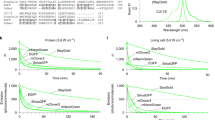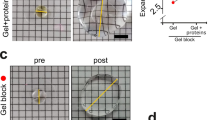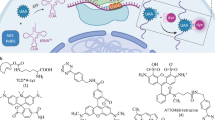Abstract
We describe a strategy for analyzing axonal transport of cytosolic proteins (CPs) using photoactivatable GFP—PAGFP—with modifications of standard imaging components that can be retroactively fitted to a conventional epifluorescence microscope. The photoactivation and visualization are nearly simultaneous, allowing studies of proteins with rapidly mobile fractions. Cultured hippocampal neurons are transfected with PAGFP-tagged constructs, a discrete protein population within axons is photoactivated, and then the activated population is tracked by live imaging. We show the utility of this method in analyzing axonal transport of CPs that have inherent diffusible pools and distinguish this transport modality from passive diffusion and vesicle transport. The analytical tools used to quantify the motion are also described. Aside from the time needed for preparation of neuronal cultures/transfection, the experiment takes 2–3 h, during which time several axons can be imaged and analyzed. These methods should be easy to adopt by most laboratories and may also be useful for monitoring CP movement in other cell types.
This is a preview of subscription content, access via your institution
Access options
Subscribe to this journal
Receive 12 print issues and online access
$259.00 per year
only $21.58 per issue
Buy this article
- Purchase on Springer Link
- Instant access to full article PDF
Prices may be subject to local taxes which are calculated during checkout



Similar content being viewed by others
References
Brown, A. Axonal transport of membranous and nonmembranous cargoes: a unified perspective. J. Cell Biol. 160, 817–821 (2003).
Roy, S. et al. Axonal transport defects: a common theme in neurodegenerative diseases. Acta Neuropathol. (Berl.) 109, 5–13 (2005).
Garner, J.A. & Lasek, R.J. Cohesive axonal transport of the slow component b complex of polypeptides. J. Neurosci. 2, 1824–1835 (1982).
Petrucci, T.C., Macioce, P. & Paggi, P. Axonal transport kinetics and posttranslational modification of synapsin I in mouse retinal ganglion cells. J. Neurosci. 11, 2938–2946 (1991).
Lasek, R.J., Garner, J.A. & Brady, S.T. Axonal transport of the cytoplasmic matrix. J. Cell Biol. 99 (1 Pt 2): 212s–221s (1984).
Koike, H. & Matsumoto, H. Fast axonal transport of membrane protein and intra-axonal diffusion of free leucine in a neuron of Aplysia. Neurosci. Res. 2, 281–285 (1985).
Kaether, C., Skehel, P. & Dotti, C.G. Axonal membrane proteins are transported in distinct carriers: a two-color video microscopy study in cultured hippocampal neurons. Mol. Biol. Cell 11, 1213–1224 (2000).
Roy, S. et al. Neurofilaments are transported rapidly but intermittently in axons: implications for slow axonal transport. J. Neurosci. 20, 6849–6861 (2000).
Wang, L. et al. Rapid movement of axonal neurofilaments interrupted by prolonged pauses. Nat. Cell Biol. 2, 137–141 (2000).
Scott, D.A. et al. Mechanistic logic underlying the axonal transport of cytosolic proteins. Neuron 70, 441–454 (2011).
Trivedi, N., Jung, P. & Brown, A. Neurofilaments switch between distinct mobile and stationary states during their transport along axons. J. Neurosci. 27, 507–516 (2007).
Kaech, S. & Banker, G. Culturing hippocampal neurons. Nat. Protoc. 1, 2406–2415 (2006).
Roy, S. et al. Rapid and intermittent cotransport of slow component-b proteins. J. Neurosci. 27, 3131–3138 (2007).
Scott, D.A. et al. A pathologic cascade leading to synaptic dysfunction in alpha-synuclein-induced neurodegeneration. J. Neurosci. 30, 8083–8095 (2010).
Patterson, G.H. & Lippincott-Schwartz, J. A photoactivatable GFP for selective photolabeling of proteins and cells. Science 297, 1873–1877 (2002).
Lippincott-Schwartz, J. & Patterson, G.H. Fluorescent proteins for photoactivation experiments. Methods Cell Biol. 85, 45–61 (2008).
Waterman-Storer, C., Desai, A. & Salmon, E.D. Fluorescent speckle microscopy of spindle microtubule assembly and motility in living cells. Methods Cell Biol. 61, 155–173 (1998).
Baitinger, C. & Willard, M. Axonal transport of synapsin I-like proteins in rabbit retinal ganglion cells. J. Neurosci. 7, 3723–3735 (1987).
Burrone, J., Li, Z. & Murthy, V.N. Studying vesicle cycling in presynaptic terminals using the genetically encoded probe synaptopHluorin. Nat. Protoc. 1, 2970–2978 (2006).
Acknowledgements
S.R. acknowledges the Larry Hillblom Foundation, the March of Dimes Foundation and the University of California, San Diego Alzheimer's Disease Research Center for their support (P50AG005131), as well as G. Patterson and J. Lippincott-Schwartz for sharing the PAGFP construct.
Author information
Authors and Affiliations
Contributions
S.R. and D.A.S. conceived the imaging experiments, performed the data analyses and wrote this paper. G.Y. originally suggested the use of the intensity-center analysis algorithm to reveal bulk motion, wrote the initial MATLAB codes (that were added to by D.A.S.) and helped in writing relevant parts of this paper. Y.T. performed imaging experiments, analyzed data and provided key insights during troubleshooting.
Corresponding author
Ethics declarations
Competing interests
The authors declare no competing financial interests.
Supplementary information
Supplementary Fig. 1
Step-wise depiction of intensity center shift quantification.(A) Following the photoactivation of cytosolic protein in the axon, the average background intensity adjacent to the activated zone was subtracted from each frame of the time-lapse movie. Images show (from top-bottom) an axon in the first frame of a time-lapse movie immediately following photoactivation; the same image following subtraction of background intensity (207.3 A.F.U). (B) The photoactivated axon was thresholded to determine the equal intensity boundaries of the photoactivated region for kymograph generation. Images show (from top-bottom) a pseudocolor image of the axon from (A) depicting the intensity fall off at the boundaries of the photoactivated zone; the thresholded photoactivated zone; a 20px polyline drawn in the proximal to distal direction over the length of the photoactivated zone. Average intensity linescans were then generated by calculating the average intensity of pixels over the width of the polyline and were used to create kymographs. (C) The kymographs shown were generated from average intensity linescans of the photoactivated axonal region from successive frames from a time-lapse movie. The table inset shows the intensities of pixels across each linescan in row vectors representing each time-point in time-lapse movies, which make up the kymographs. The pseudocolor kymograph shows the anterograde biased movement of the photoactivated fluorescent mass towards the distal end of the axon, and the plot to the right shows the calculated intensity center shift of the photoactivated GFP population over a 60s time-lapse movie. (PNG 142 kb)
Supplementary Video 1
Principles of intensity-center analysis. A temporally-linked composite showing the mobility of the PAGFP:synapsin after photoactivation (greyscale, top); the resultant pseudocolor kymograph in the center (middle); and the intensity-center data below (the quantitative center is marked with a red dot to facilitate visualization of the shift). Note the shift in the curves (displacement of the red dot) corresponds to the anterogradely-biased transport of the fluorescent plume as seen in the kymograph and the greyscale image. Gaussian curves are shown for ease of visualization, but the data are similar to that from raw intensity-values. (MOV 5619 kb)
Rights and permissions
About this article
Cite this article
Roy, S., Yang, G., Tang, Y. et al. A simple photoactivation and image analysis module for visualizing and analyzing axonal transport with high temporal resolution. Nat Protoc 7, 62–68 (2012). https://doi.org/10.1038/nprot.2011.428
Published:
Issue Date:
DOI: https://doi.org/10.1038/nprot.2011.428
This article is cited by
-
Developments in preclinical cancer imaging: innovating the discovery of therapeutics
Nature Reviews Cancer (2014)
-
Assessing the Subcellular Dynamics of Alpha-synuclein Using Photoactivation Microscopy
Molecular Neurobiology (2013)
Comments
By submitting a comment you agree to abide by our Terms and Community Guidelines. If you find something abusive or that does not comply with our terms or guidelines please flag it as inappropriate.



